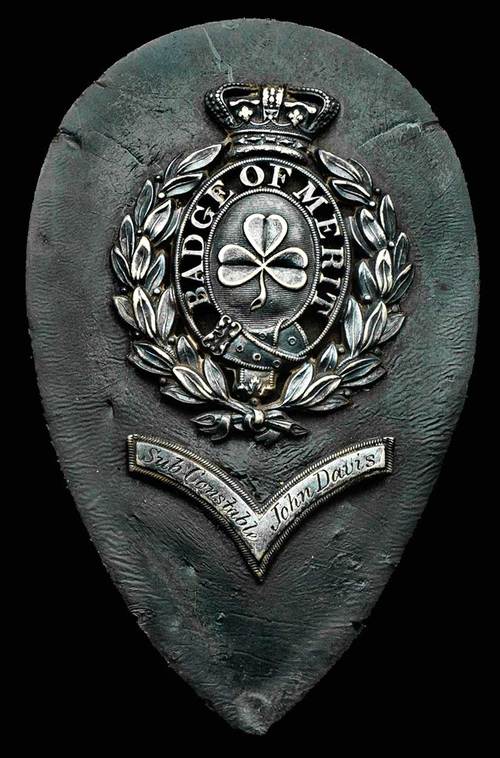
Auction: 323 - The Numismatic Collector's Series Sale
Lot: 725
A Royal Irish Constabulary Badge of Merit with One Chevron to Constable John Davis, For Gallantry During the Defence of the R.I.C. Barracks at Kilmallock When it Came Under Sustained Fenian Attack, 6.3.1867- 18 Guns and 37 Pikes Were Amongst The Weapons Recovered From the Battlefield
An R.I.C. Badge of Merit, silver, Shamrock in centre, 'Badge of Merit' inscribed on a garter, crown above, all surrounded by a laurel wreath, chevron below inscribed 'Sub Constable John Davis', all mounted on a leather backplate, very fine
31898 Sub Constable John Davis served with the Limerick Royal Irish Constabulary, and was awarded the Chevron together with a gratuity of £15 for defending Kilmallock R.I.C. Barracks when it was attacked by a party of armed insurgents on the 6th March 1867.
The Battle of Kilmallock
The Battle started on the evening of the Shrove Tuesday, 5th March 1867, when members of the Fenian Brotherhood from Bruree gathered at the railway bridge in the village and, armed mainly with pikes, marched to Tankardstown, where they met more insurgents. The combined group then made its way to Kilmallock, gathering guns along the way, to attack the R.I.C. Barracks. There were 13 constables in the barracks, under Head Constable Richard Adams. Acting on intelligence that the Barracks was due to be attacked, the lights remained on until shortly before 6:00am on the morning of Ash Wednesday, 6th March. The going out of the lights in the barracks was the signal for the Fenians to attack. 'Falling in four deep in Gabbett's Field, they marched to the barracks, which was about a mile distant. At their head was Captain Dunne. Some of the men had firearms, but the majority had only pikes. The barracks, a strong stone building, stood on its own, a few yards back from the side of the street. Before it there was a wall about three feet high. Some of the Fenians took up their position on the street side of this wall; others took up positions at the rear of the barracks. One man advanced to the barrack door, poured some paraffin oil on it, and attempted to set it alight. Returning to his position he fired the signal shot which set off the attack. Volley after volley was exchanged between the police and their attackers. Before long it became apparent to the latter that if they were to take the barracks they would have to blow a hole in one of the walls of the building or burn down the door. Two quarrymen were brought up and put to work drilling holes in one side of the walls of the barracks, with the object of blowing it up. This attempt was later abandoned, and a barrel of tar and straw was instead placed against the barrack door and set on fire, but without the desired effect of setting the door alight.
Daylight came, bringing with it for the Fenians the added danger of recognition by the police. But still the fight continued, the fire of the Fenians being answered by the regular military-style volleys of the police. The turning-point, however, was soon to come. At 6:30 that morning Mr. Milling, Sub-Inspector of Police at Kilfinane, had set out for Kilmallock in the company of three policemen. They had almost reached Kilmallock when they heard the sound of gunfire and, learning what was afoot, they returned to Kilfinane for reinforcements. Arriving back at Kilmallock with a party of ten policemen, Milling and his men opened fire on the Fenians in front of the barracks shortly before 10 o'clock in the morning. Already, many of the pikemen, all too aware of the inadequacy of their equipment in the kind of fight that had developed, had dumped their weapons and had disappeared in the darkness of the early morning. But the men who had the guns had held their positions and were still fighting. Now, however, under pressure from the cross-fire, those in front of the barracks had to retreat. A brief council of war was held. Some were for fighting it out to a finish, but on the advice of Captain Dunne it was agreed that further resistance, against 25 well-trained policemen, would be useless. And so the Fenians decided to scatter in various directions. Dunne shook hands with them, bade them farewell, and then mounting a horse rode off. He succeeded in escaping out of the county and making his way to the United States.' (The Story of Kilmallock, M. Seoighe refers).
Three Fenians were killed in the attack, including Dr. Michael Clery, the insurgent's medical officer. He knew that his sister and his fiancée would be at Mass that morning in Kilmallock, it being Ash Wednesday, and when it neared the time when they were due to return from church he set off to warn them not to come by way of the police barracks. He had only gone a short distance when he was hit by a police bullet, and died in a matter of minutes. 18 guns, 37 pikes, two swords, about 14lbs of bullets, a crowbar, a pickaxe, and 2 sledgehammers were recovered by the police from the battlefield.
Sold for
$3,000




